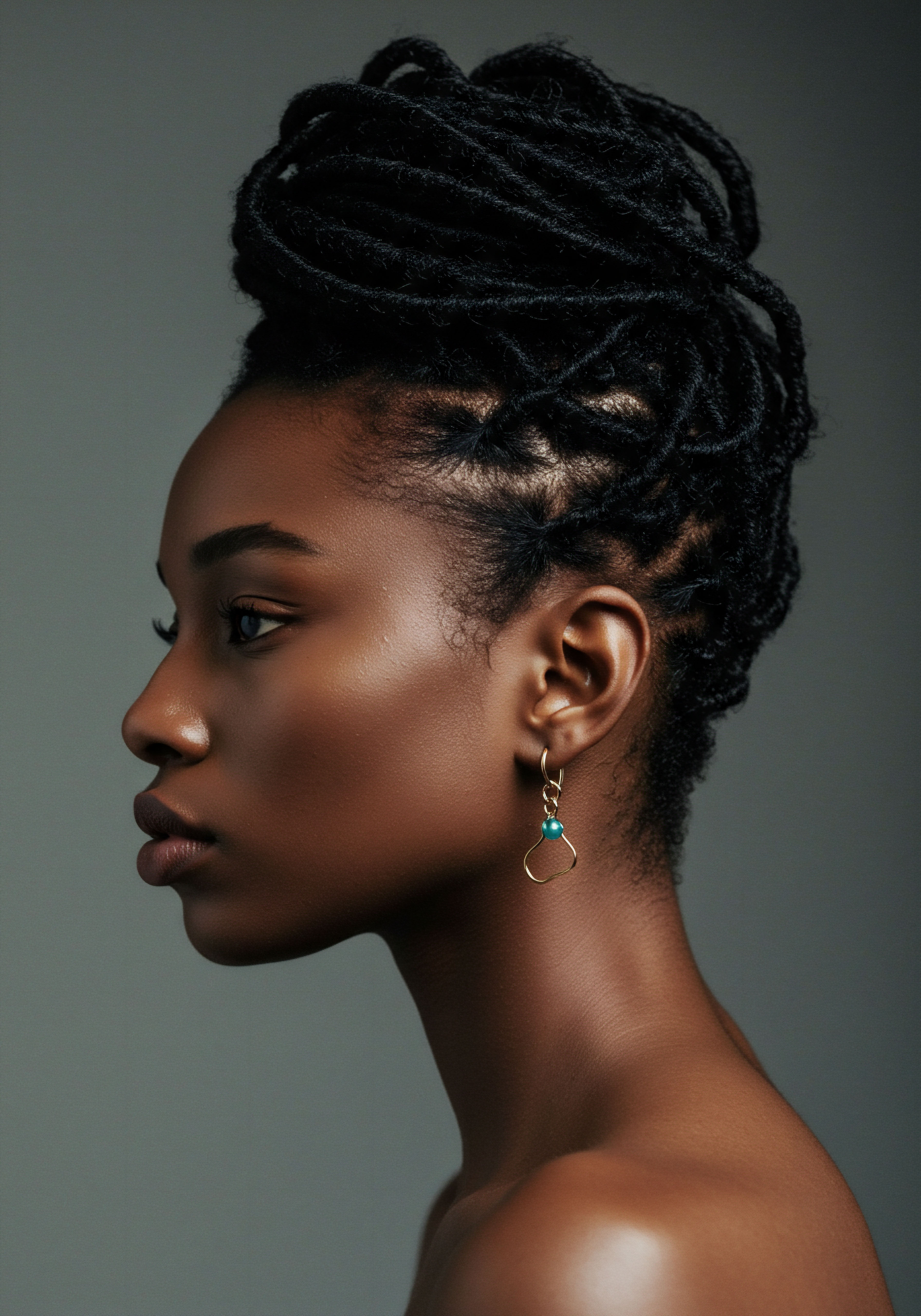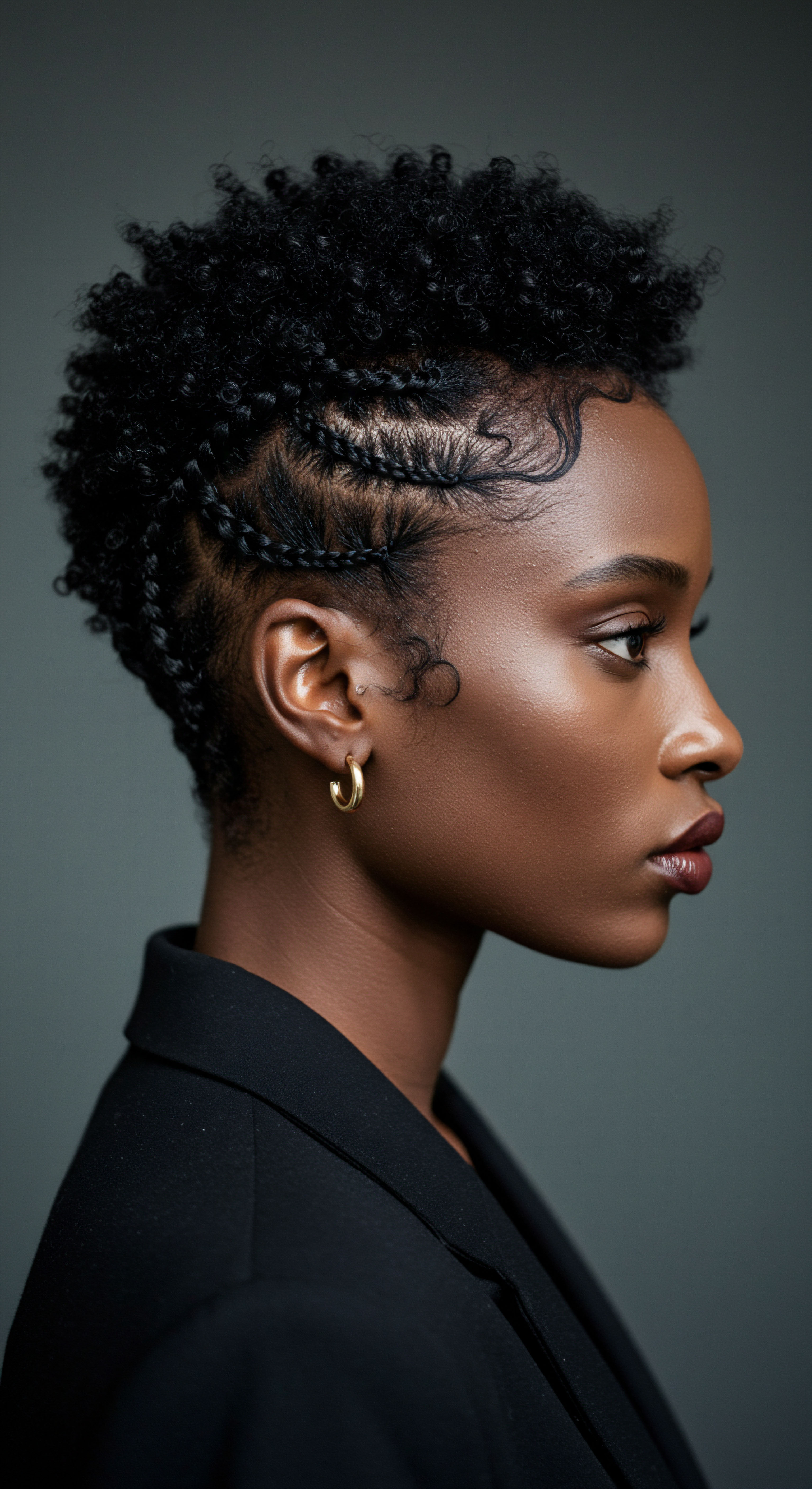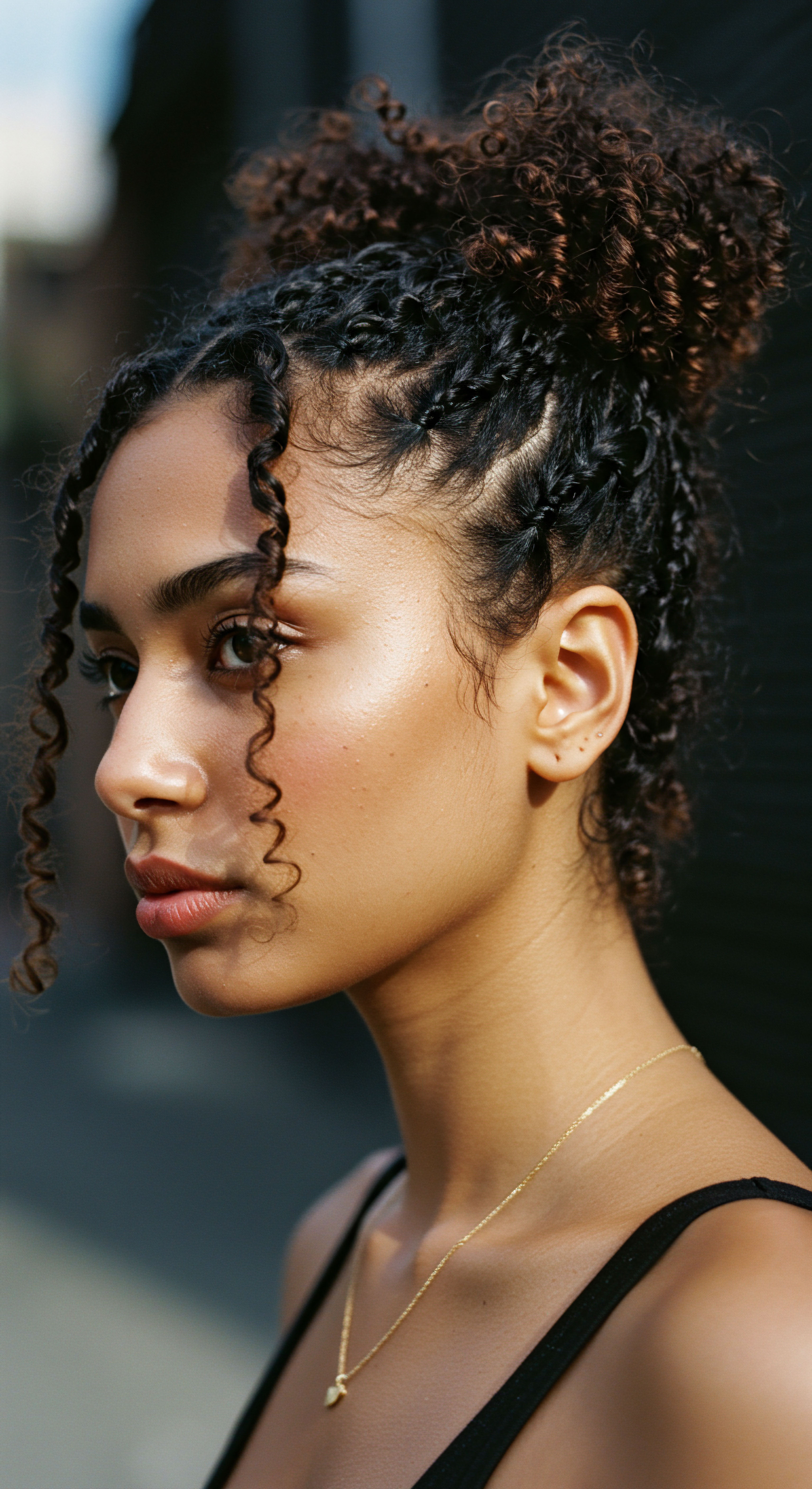
Roots
The quiet rustle of leaves, a familiar whisper from ancient lands, carries within it the story of henna. Before its intricate patterns graced celebratory hands or dyed hair with rich auburn tones, the plant Lawsonia inermis offered a cooling solace in arid climates. Early communities, perhaps noticing the temporary stain left on skin or hair by crushed leaves, began to recognize a unique property. This humble botanical, with its distinctive reddish-brown pigment, lawsone, began its subtle journey from a simple desert remedy to a profound cultural marker across vast distances.
The earliest documented uses of henna reach back over 5,000 years, connecting civilizations across continents. Ancient Egypt, a cradle of early practices, utilized henna not merely for adornment but also for ritualistic purposes. Mummies have been discovered with nails stained by henna, suggesting a belief in its spiritual significance for the afterlife.
Beyond the Nile, evidence points to its use in ancient Ugarit, in modern-day Syria, where texts from 1500-1200 BCE speak of henna as a medicinal prescription for pain. This dual function, both practical and symbolic, laid the groundwork for its widespread adoption.
Henna’s journey began with its cooling and medicinal properties, quietly transforming into a cherished symbol across ancient civilizations.

What Were Henna’s First Applications?
The initial applications of henna were deeply intertwined with the immediate needs of communities living in hot environments. People would create a paste from the plant’s crushed leaves and apply it to their palms and soles, benefiting from its natural cooling effect as the moisture evaporated. This practical application gradually revealed its staining properties, leading to its adoption for body art and hair dyeing.
Early medicinal scrolls, such as the Ebers Papyrus from Ancient Egypt, document henna’s role in treating ailments like ringworm, wounds, and burns. This early scientific observation of its properties, even if rudimentary, underscored its value beyond mere aesthetics. The understanding that henna could soothe skin, reduce pain, and even possess antimicrobial qualities propelled its acceptance and distribution among diverse populations.
- Cooling ❉ Applying henna paste to hands and feet offered relief from intense heat.
- Medicinal ❉ Used for skin conditions, headaches, and wound treatment.
- Adornment ❉ Its staining property led to its use for body art, hair, and nails.

How Did Early Routes Shape Henna’s Distribution?
The movement of henna from its native regions of North Africa, the Middle East, and South Asia was largely facilitated by ancient trade routes. The Silk Road, a network of pathways connecting East and West, served as a conduit for not only goods but also cultural practices. As merchants, travelers, and nomadic groups traversed these routes, they carried with them not just henna powder but also the knowledge of its preparation and significance.
This early cultural exchange was not a one-way street. As henna reached new lands, it encountered different climates, plant species, and local customs. While the core plant, Lawsonia inermis, might have struggled to thrive in all new environments, the idea of temporary body adornment with plant-based dyes found fertile ground.
This led to local adaptations, sometimes substituting henna with other staining plants like garden balsam in regions like ancient China, where the concept of dyeing nails with red plant dyes became popular, even if the plant itself was different. This assimilation highlights how cultural concepts, rather than just raw materials, traveled and reshaped traditions.
| Region of Origin North Africa, Middle East |
| Primary Direction of Spread Eastward to India, Westward to Mediterranean |
| Key Facilitating Factors Ancient trade routes, nomadic movements, early civilizations |
| Region of Origin Indian Subcontinent |
| Primary Direction of Spread Westward to Middle East, Eastward to Southeast Asia |
| Key Facilitating Factors Trade, religious pilgrimages, empires |
| Region of Origin Mediterranean Coast |
| Primary Direction of Spread Inland through Roman influence, Punic civilization |
| Key Facilitating Factors Conquest, cultural assimilation, medicinal use |
| Region of Origin Henna's early spread was a testament to interconnected ancient societies. |

Ritual
Stepping from the foundational properties of henna, we arrive at the realm of ritual, where its simple application transformed into deeply meaningful practices. The quiet act of staining skin or hair evolved into communal celebrations, rites of passage, and expressions of collective identity. Across diverse lands, the plant’s dye became a medium for conveying blessings, protection, and joy, its presence marking significant life events with vibrant hues. This shift from utilitarian use to symbolic artistry showcases humanity’s capacity to imbue the natural world with profound cultural weight.

How Did Ceremonies Adopt Henna?
Henna’s adoption into ceremonial life was a gradual process, likely stemming from its association with health and well-being. Its cooling properties in hot climates and perceived medicinal benefits made it a natural choice for auspicious occasions, symbolizing purity and protection. Over centuries, these associations deepened, and specific application methods and designs became standardized within particular cultural contexts.
In many societies, the bridal ceremony stands as a paramount example of henna’s ritualistic significance. In South Asia, the mehndi ceremony, often held days before a wedding, involves intricate designs applied to the bride’s hands and feet. These patterns are not merely decorative; they carry wishes for prosperity, fertility, and a strong marital bond.
The darker the stain, a popular belief suggests, the deeper the love between the couple. Similarly, in North Africa and the Middle East, “Night of the Henna” gatherings precede weddings, uniting women in celebration and adornment, with henna symbolizing good health and warding off ill fortune.
Henna became a ceremonial cornerstone, its patterns carrying blessings and protection for life’s important moments.

What Are Henna’s Regional Artistic Expressions?
As henna traveled, its artistic expressions diversified, each region contributing its unique aesthetic. These regional variations speak volumes about the visual languages and cultural priorities of different communities. The geometric patterns seen in Moroccan henna, for instance, often feature bold lines and negative space, reflecting a distinct artistic heritage.
Conversely, Indian henna, known as mehndi, typically showcases extreme intricacy with fine lines, floral motifs, paisleys, and mandalas that often cover entire hands and feet. This difference in style is not arbitrary; it speaks to varying artistic traditions and cultural interpretations of beauty and symbolism. The cultural exchange was not about one style dominating, but about adaptation and the creation of new visual vocabularies.
Even within broader regions, distinct local styles emerged. For example, in Mali, West Africa, a unique method involves using thin strips to block areas, creating bold straight-line designs once the paste is removed. These patterns often carry symbolic meanings, such as repeated triangles representing fish scales, a sign of good fortune and abundance. This localized innovation demonstrates how communities actively shaped henna traditions to align with their specific cultural narratives.
- Indian Mehndi ❉ Characterized by extreme detail, floral designs, paisleys, and mandalas.
- Moroccan Henna ❉ Features bold, geometric patterns with significant negative space.
- Sudanese Henna ❉ Often uses larger, less detailed patterns, sometimes with abstract floral or vine motifs.
- Malian Diabi ❉ Distinct for its use of tape or strips to create bold, linear, often symbolic patterns.
| Region South Asia (India, Pakistan) |
| Dominant Design Elements Intricate floral, paisley, mandala patterns, fine lines |
| Typical Coverage Area Full hands and feet, often extending up arms/legs |
| Region North Africa (Morocco, Algeria) |
| Dominant Design Elements Bold geometric shapes, abstract motifs, emphasis on negative space |
| Typical Coverage Area Palms, soles, sometimes extending to wrists/ankles |
| Region Middle East (Arabian Peninsula) |
| Dominant Design Elements Vines, floral sprays, sometimes simpler, more open designs |
| Typical Coverage Area Hands, feet, sometimes hair or beard for men |
| Region West Africa (Mali, Somalia) |
| Dominant Design Elements Linear, triangular, and tribal motifs, often bold and graphic |
| Typical Coverage Area Hands, feet, sometimes neck or arms |
| Region Each region developed a visual language for henna, reflecting local artistic heritage. |

Relay
From the established rituals, henna’s journey continues, stretching into more complex dimensions where its physical properties and cultural interpretations intersected with broader societal shifts. This is where the story deepens, moving beyond mere application to consider the profound impact of trade, migration, and even political forces on its evolution. Henna became a conduit for shared knowledge, a testament to resilience, and sometimes, a quiet point of contention, revealing the intricate layers of human interaction.

How Did Henna’s Chemistry Shape Its Cultural Trajectory?
The core of henna’s enduring appeal lies in its chemical composition, specifically the lawsone molecule, which binds to keratin proteins in skin, hair, and nails, creating a temporary stain. This natural property, discovered and refined over millennia, made it a valuable commodity and a versatile tool. Early practitioners, through empirical observation, understood how to prepare the paste for optimal color release, using acidic liquids like lemon juice or tea to enhance the dye. This practical science, passed down through generations, allowed for consistent results, reinforcing its reliability across various uses.
The knowledge of lawsone’s interaction with keratin also influenced how different cultures approached hair dyeing. While body art became prominent in many regions, henna also served as a natural hair dye, offering shades from orange to auburn. In some Islamic traditions, for instance, henna was used by men to color beards, a practice endorsed by the Prophet Muhammad, often to distinguish themselves or to cover greys. This application highlights how scientific understanding (even if unarticulated in modern terms) of henna’s binding properties directly shaped cultural practices and religious observances.

What Impacted Henna’s Global Spread?
The widespread adoption of henna was not solely a matter of aesthetic appeal; it was propelled by extensive networks of exchange. The ancient trade routes, particularly the Silk Road, played a paramount role. Beyond silk and spices, these arteries of commerce carried cultural practices and materials. Historical accounts and textual research reveal henna’s presence in ancient China, where its application for nail decoration was influenced by foreign henna art.
A study titled “Textual Research on Henna Art Introduced into Ancient China Through the Silk Road” indicates that Chinese customs of dyeing red nails were indeed affected by foreign henna art, undergoing three development stages ❉ introduction (Western Jin to Tang Dynasty), development (Song-Yuan Dynasty), and popularity (Ming-Qing Dynasty). This specific example shows how a foreign practice could be assimilated and localized, demonstrating the profound influence of long-distance cultural contact.
Migration patterns also played a significant role. As populations moved, whether due to trade, conquest, or voluntary resettlement, they carried their traditions with them. Jewish communities from North Africa and the Middle East, for example, adopted and adapted henna ceremonies from their Muslim neighbors, making it an important part of Sephardic wedding traditions. Even after mass migrations in the mid-20th century led to a temporary decline in some traditions, there has been a resurgence of cultural pride, bringing these practices back into prominence.
The interplay of religion and trade further solidified henna’s place. Its mention in Islamic texts, including the Hadith, for both cosmetic and medicinal uses, granted it a sacred status, encouraging its widespread adoption throughout the Islamic world. This religious sanction, combined with existing trade networks, ensured its diffusion across North Africa, the Middle East, and parts of Asia, creating a shared cultural language expressed through body adornment.
Trade routes and migration served as powerful conduits, transforming henna from a regional practice into a global cultural phenomenon.

How Did Colonialism Affect Henna Practices?
The colonial era introduced another layer of complexity to henna’s story. European powers, during their presence in regions where henna was traditional, often observed and documented these practices. While some instances saw a Western fascination with “exotic” body art, leading to its eventual adoption in new contexts (such as European women using henna for hair dye in the 19th century), other interactions were less harmonious.
In some cases, traditional practices faced suppression or alteration under colonial rule, as local customs were sometimes viewed through a lens of “otherness.” However, henna’s deep roots in local cultural and religious life often meant it persisted, sometimes subtly, sometimes openly. The resilience of these traditions speaks to their intrinsic value within communities, surviving periods of external pressure and re-emerging, often with new adaptations, in post-colonial contexts. This demonstrates how cultural exchange, even when imposed, can lead to both disruption and remarkable continuity.
- Cultural Diffusion ❉ Henna traveled along ancient trade routes like the Silk Road.
- Religious Sanction ❉ Islamic texts encouraged its use, aiding its spread.
- Migration ❉ Communities carried traditions, leading to adaptations in new lands.
| Influence Type Trade Routes |
| Mechanism of Spread Exchange of goods, ideas, and practices across continents |
| Examples of Impact Silk Road introducing henna art to ancient China |
| Influence Type Religious Expansion |
| Mechanism of Spread Adoption of practices within new religious contexts |
| Examples of Impact Islamic traditions popularizing henna across North Africa and Middle East |
| Influence Type Migration & Diaspora |
| Mechanism of Spread Communities carrying traditions to new homelands |
| Examples of Impact Sephardic Jewish communities adopting henna rituals from neighbors |
| Influence Type Colonialism |
| Mechanism of Spread Documentation, adaptation, or suppression of local practices |
| Examples of Impact European women adopting henna for hair dye in 19th century |
| Influence Type Henna's journey is a mirror reflecting human movement and interaction throughout history. |

Reflection
The journey of henna across continents and centuries is a quiet testament to the enduring human desire for expression, connection, and well-being. It began as a practical solution in harsh climates, then bloomed into a symbol of celebration and identity, continually adapting to new hands and new meanings. From ancient mummies to modern brides, from cooling balm to intricate artistry, henna’s story is one of profound cultural dialogue, a constant whisper of shared heritage across time and place.

References
- Alassadi, F. (2023). Feminism, Medicine and Culture ❉ How chemical/medicinal properties, international culture and historical significance of Henna shape best practices in application.
- Cartwright-Jones, C. (2006, 2007, 2008). North African Henna. The Henna Page.
- Doumas, C. (1992). The Wall Paintings of Thera.
- Nayak, M. & Ligade, V. S. (2021). History of natural ingredients in cosmetics. Cosmetics, 10(3), 71.
- Sharaby, R. (2012). The Bride’s Henna Rituals ❉ Symbols, Meanings and Changes. Journal of Ritual Studies, 26(2), 53-70.
- Sherrow, V. (2006). Encyclopedia of Hair ❉ A Cultural History. Greenwood Press.
- Yang, X. & Liu, Y. (2020). Textual Research on Henna Art Introduced into Ancient China Through the Silk Road. Asian Social Science, 16(9), 21.